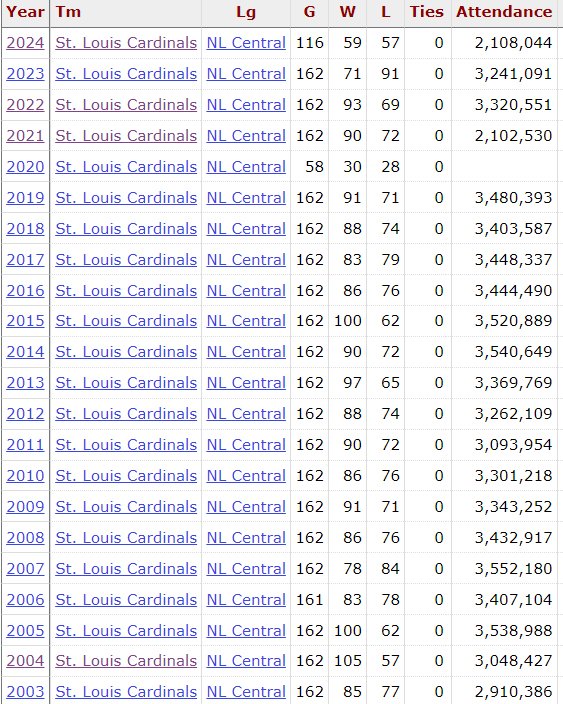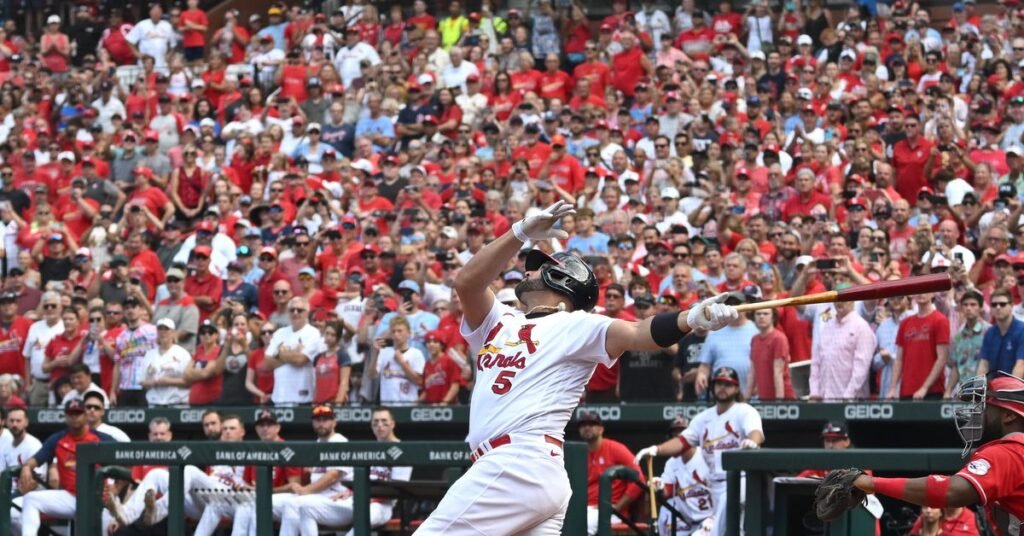Attendance: A Closer Look
Let’s address the elephant in the room—attendance at Cardinals games is down this season. It’s been noticeable in the stands, and despite some early optimism that warmer weather and improved performance would draw more fans, that hasn’t been the case.
As of this Friday, the Cardinals have played 58 games at home and 58 on the road. The recorded “attendance,” which counts tickets sold, stands at 2,108,044. This figure is announced at the games, though it often doesn’t reflect the actual number of people present in the stadium.
On average, that’s 36,345.5 tickets sold per home game. While this number might be enviable for many other MLB teams, it’s a disappointing figure for the Cardinals’ ownership.
Projecting this trend forward, the Cardinals could end the season with about 2.944 million tickets sold—a significant drop from the team’s usual goal of at least 3 million.
Historically, the Cardinals have consistently exceeded the 3 million mark in attendance. Last season, despite a poor 71-91 record, the team still managed to draw 3.241 million fans. That’s nearly 300,000 more fans than this season’s projection, despite the Cardinals’ better performance this year and efforts to improve at the trade deadline.
Looking further back, the trend is even more concerning. The last time the Cardinals drew fewer than 3 million fans in a season (excluding the COVID-impacted 2020 and 2021 seasons) was in 2003, when they barely missed the playoffs with just over 2.9 million fans. Since then, the team has enjoyed 20 years of consistently strong attendance.
From 2014 to 2019, the Cardinals never dipped below 3.40 million in attendance, averaging 41,975 tickets sold per game during that period. This season’s projected 2.944 million puts them about 12.2% below that pace—a significant drop, especially considering the team has been winning and playing well since early May.

The reasons for this decline in attendance are up for debate, and I invite you to discuss them in the comments. But today, I want to focus on what this decline means for the Cardinals’ future payroll.
There’s a common belief that a drop in attendance could lead to a decrease in payroll. While we can’t draw a direct 1-to-1 parallel between ticket sales and payroll, it’s likely that lower revenue could impact the team’s spending.
Using the average ticket price of $38.43, we can estimate that the Cardinals are earning $1,613,099.25 per game in gross revenue based on their 2014-2019 attendance average. This season, with fewer fans, that number drops to $1,396,757.57 per game—a loss of $216,341.69 per game, or $17,523,676.49 over the course of the season.
While this is just an estimate and doesn’t account for other factors like premium seating or suite sales, it’s clear that a drop in attendance could have financial implications.
Even if the decline in revenue isn’t exactly proportional to the decline in payroll, it’s hard to ignore the potential impact. The Cardinals have historically tied payroll to attendance, so a significant drop in ticket sales could lead to tighter budgets.
However, I don’t expect a drastic decrease in payroll for next season. The Cardinals have typically increased payroll by 4-6% annually, and even if they don’t this year, they’re likely to maintain a similar level of spending.
There are also other factors at play, such as the Bally TV contract, which could affect revenue and, consequently, payroll. Until we know more about that situation, it’s difficult to predict the exact impact.
In the meantime, there’s something fans can do—attend games. The more fans that fill the stands, the more revenue the team generates, which could help maintain or even increase payroll.
So, if you’re able, head to a game this weekend. Enjoy the atmosphere at Busch Stadium, and let’s hope the Cardinals give us plenty of reasons to keep showing up.



